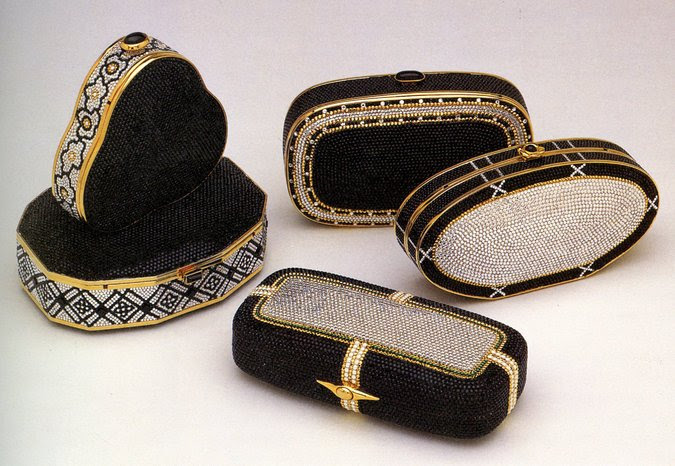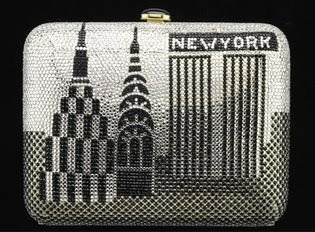정준모
Judith Leiber, 97, Dies; Turned Handbags Into Objets d’Art

Judith Leiber, the handbag designer whose whimsical creations were prized as collectors’ pieces and frequently displayed as objets d’art, died on Saturday at her home in Springs, N.Y., a hamlet in East Hampton. She was 97.
Ms. Leiber died just hours after the death of her husband of 72 years, the painter, lithographer and sculptor Gerson Leiber, who was known as Gus. He also died at their home.
Both died of heart attacks, according to Jeffrey Sussman, their biographer and spokesman, and they were buried together on Monday.
In recent years the couple had mounted joint exhibitions of their work on Long Island and in Manhattan.
Stella Blum, the curator of the Costume Institute at the Metropolitan Museum of Art until 1983, once said that describing Judith Leiber as an accessory designer was “a little like calling Louis Comfort Tiffany a designer of lighting fixtures.”
Her handbags were often on view in museums and are in the permanent collections of a number of them, including the Metropolitan Museum of Art, the Smithsonian Institution and the Chicago Historical Society. Ms. Leiber nevertheless demurred when Andy Warhol described her bags as works of art. “Truthfully, I don’t consider them art,” she said. “I’m an artisan.”
Although she designed luxurious handbags with discreet clasps and frames for daytime, she was best known for her imaginative and eye-catching evening creations, among them colorfully beaded bags in animal, flower, fruit and egg shapes, and bags shaped like boxes and shells with variations on antique Asian motifs.

Geometric jet and rhinestone boxes. Clockwise from left: octagon box, 1986; clover shaped box, 1989; oblong box with onyx and rhinestone trim, 1985; oval box with jet and rhinestone, 1992; oblong box with jet, rhinestone and pearl decorations, 1973. CreditJohn Bigelow Taylor
Her classically shaped metal evening bags were built of cardboard and sent to Italy, where they were stamped in brass. The animal forms and more complex shapes began as sculptured wax models and were also sent to Italy to be copied in metal. Feet and ears were cast separately and soldered on; other parts and touches, like the head of a horse or the bow on a cat, were stamped in two halves and joined seamlessly.
The gold plating was done after the bags were returned to America. So was the encrusting of the bag in rhinestones and other beads.
A number of Ms. Leiber’s clients amassed scores, and in several cases hundreds, of her designs, despite price tags that reached well into four figures for each bag.
At major charity events, it was common for a woman who had left her Leiber evening bag on the table while she danced to find on her return that other guests had gathered around her table to admire it. Occasionally a bag would disappear, returned only when admirers had finished passing it around.

“Sensuous and tactile, they ask to be picked up,” said Dorothy Twining Globus, a former director of the Museum at the Fashion Institute of Technology and curator of exhibitions at the Museum of Arts and Design.
Most of Ms. Leiber’s evening bags, particularly the glittering metal creations, were designed to hold a bare minimum of necessities. She allowed that lipstick, a handkerchief and a $100 bill might possibly fit. A $100 bill? Not small change, she admitted, but not unreasonable for a Leiber bag owner. As for carrying such necessities as eyeglasses, keys and a few other odds and ends, she would ask, “What’s an escort for?”
Ms. Leiber created five collections a year, in all about 100 designs. She said she was inspired by paintings, museum pieces, artifacts and nature. One of her most popular bags was shaped like a snail; another, an example of the commonplace made uncommon, was fashioned from an antique quilt and enhanced with bits of colored glitter.
The women who carried Leiber bags included first ladies, queens and princesses, and celebrities like Greta Garbo, Claudette Colbert, Diana Ross and Joan Sutherland. Queen Elizabeth II was presented with a bag during a visit to California, and Raisa Gorbachev, the wife of the Soviet leader, received one from Barbara Bush.

"Lightning" egg with drop-in chain, 1971.CreditJohn Bigelow Taylor
Mrs. Bush carried a Leiber design at her husband’s inaugural ceremony. She also had one of the Leiber metal bags shaped, with slight variation, to resemble Millie, her springer spaniel. It was later duplicated and sold for $2,500. Other first ladies were customers as well: Nancy Reagan ordered white satin Leiber bags for both her husband’s inaugural balls, and Hillary Clinton had a bag modeled after Socks, the family cat.
But even the first ladies couldn’t compete in patriotism with a Texan who was invited to one of the Clinton inaugurations and ordered a bag beaded with the stars and stripes on one side and the Statue of Liberty on the other.
Many of Ms. Leiber’s customers used the bags for aesthetic purposes as well as practical ones. Some displayed them in a vitrine or étagère, and one Los Angeles matron invited her friends, their Leiber bags and their husbands to a dinner party. When they arrived, she took all their bags and lined them up on a mirror, flanked with votive candles, running down the center of the dining table. It was a table decoration not soon forgotten.
Ms. Leiber maintained that a story of a husband who had given his wife 14 Leiber bags in seven years and wanted them back as part of a divorce settlement was not apocryphal. “I could retire on your Leiber bag collection,” he reportedly said. The wife kept the bags.

The Leibers’ wedding engagement portrait from 1946.CreditThe Leiber Museum
Ms. Leiber was born Judith Marianne Peto in Budapest on Jan. 11, 1921. Her parents, Emil and Helen Peto, hoped that she would become a chemist and repeat the success of a relative who had developed a complexion cream. In 1939, she was sent to England to pursue scientific studies, but World War II intervened and her theoretical cosmetics empire vanished.





FAMILY SITE
copyright © 2012 KIM DALJIN ART RESEARCH AND CONSULTING. All Rights reserved
이 페이지는 서울아트가이드에서 제공됩니다. This page provided by Seoul Art Guide.
다음 브라우져 에서 최적화 되어있습니다. This page optimized for these browsers. over IE 8, Chrome, FireFox, Safari